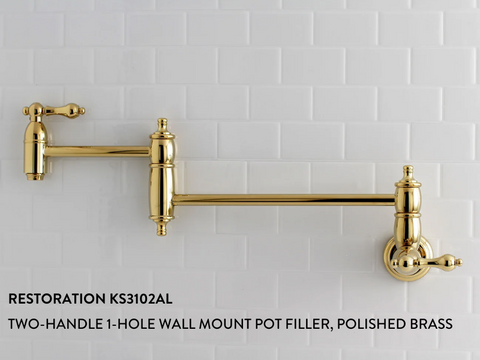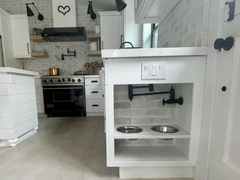
How to Create a Dog Feeding Station
In the core of every pet household, dogs hold a cherished place as part of the family. This significance is evident in the way we splurge on tasty treats, pick out the cutest, fluffiest toys, and even in the way we forgive when they make a mistake. If you’re looking for a way to spoil your pup even more, look no further, and establish an area as your dog’s very own real estate… in the form of a feeding station! A well-designed station caters to your pet's dietary needs, enhances daily routines, and fosters a harmonious living environment. Its importance lies in fostering routine, discipline, and health, ensuring organized and accessible meals for your dog. An organized area showcases your care and streamlines feeding and cleanup, reducing stress for both your dog and yourself. This article focuses on creating the ultimate dog feeding station by integrating faucets, offering convenience for hydration and culinary needs, and guiding you through the design process to plan out your dog’s allowance of square footage.
The Best Placement for a Pet Feeding Station
The first step in crafting an effective feeding station is choosing the right location. Consider placing it in an area of your home that is easily accessible and frequented by both you and your dog. The kitchen, for example, often proves to be a popular choice, as it’s close to other food and water. In the kitchen, you can place a feeding station against a counter or on the end of an island. Another option is near the doggy door, an area your pet likely frequents. Above all, use the space you have; get creative with vertical space if you’re working with a small area. If you have multiple dogs or a larger area to work with, try allotting just enough space to be effective but not a main focal point.
Accommodating to Your Dog’s Breed, Size, and Needs
One size does not fit all when it comes to a dog feeding station. The size, breed, and specific needs of your dog should dictate the design. For larger breeds, raised feeding platforms may provide added comfort and promote better digestion, while smaller breeds may benefit from bowls placed at ground level. Understanding your dog's eating habits and posture can guide you in creating an ergonomically sound feeding space.

Design elements such as the height of the bowls can significantly impact your dog's posture and digestion. A well-thought-out design not only prevents strain on your dog's neck and joints but also encourages a relaxed and enjoyable dining experience. A straightforward way to calculate the approximate height your dogs feeding station surface should be placed at, measure from the front paws to the top of the shoulder of your dog. Use that measurement as the maximum height placement for the surface of the feeding station, take away 5-inches and use that measurement as your minimum placement height. In some cases, for small breeds, the floor might be the most suitable height.
Things to Consider
-
Feeding Bowl Material:
-
Elevated vs. Ground Level Feeding Height:

-
Food Freshness:
Storing dog food in airtight containers prevents moisture, air, and pests from affecting its quality.Choose containers with a secure seal to keep kibble fresh and appetizing, maintaining its nutritional value over time. Avoid containers with foam gaskets, as they can easily fall out or become deformed over time. You can also build an area to enclose the food container so that any mismatched products can be hidden.
-
Organization:
For an organized feeding station, include designated compartments for treats, supplements, and other essentials. This not only streamlines your dog's dietary regimen but also adds a level of order and convenience to the space. If the area is ultimately going to house items unrelated to food, such as leashes, waste bags, or toys, calculate this into your feeding station design to reap the organization's benefits in the long run. -
Floor Protection:
Prevent spills and slips by incorporating non-slip mats or flooring around the feeding station. Floor mats add an extra layer to catch any water drippings or spilled food, keeping the floor tidy, while non-slip mats can be used to keep water and food bowls in place.
A Faucet for Your Furry Friend
A dedicated faucet in the feeding station gives your dog easy access to clean, fresh water.
This is particularly valuable for maintaining proper hydration, especially during warmer months or after energetic play. The convenience of an integrated faucet simplifies the process of refilling water bowls. No longer do you need to carry heavy pitchers or navigate through the kitchen with overflowing bowls? Instead, a quick turn of the faucet handle ensures a continuous water flow. Check out our wall-mount for getting creative with your faucet placement. Also, check out our deck-mount for a traditional faucet setup.
Pot Fillers
Pot filler faucets, initially designed for filling large pots in kitchens, find a surprising and ingenious application in the dog feeding station. These foldable faucets are mounted on the wall near the station, allowing you to fill water bowls with ease and precision.
Installing a Pot Filler
The installation of faucets requires connecting them to the water supply lines, which should be easily accessible as they are commonly routed throughout the kitchen. Professional guidance and installation is recommended if you don’t already have an existing pot filler.
The aesthetics of the feeding station are not overlooked with the inclusion of faucets. Select a faucet style and finish that complements the overall design of the station while also fitting seamlessly into your home's décor. Quality is paramount when it comes to faucets. Opt for durable, well-constructed faucets that are designed to withstand frequent use. Proper installation and maintenance also play a role in preventing leaks and ensuring long-term functionality. Whether your interior design leans towards rustic, modern, or eclectic, there are faucets available in various designs to complement your taste.
A standout element of building a dog feeding station has been the integration of faucets and pot filler faucets. These additions have the power to transform the feeding station into a hub of convenience, ensuring easy access to water for hydration, cleanliness, and culinary pursuits alike. In the spirit of companionship and creativity, we encourage you to take the insights gained from this article and bring them to life in your own home. Craft a space that not only caters to the practical aspects of feeding but also serves as a visual testament to the remarkable relationship you share with your dog. May your home be filled with wagging tails, contented bellies, and the enduring bonds of love.






